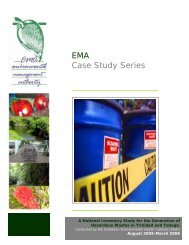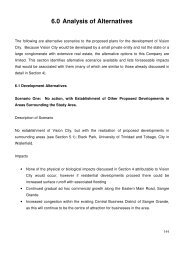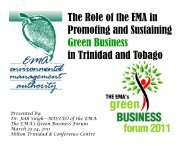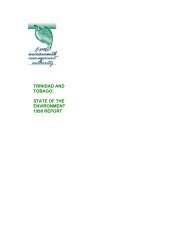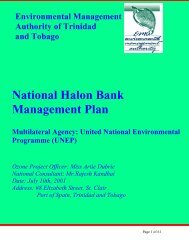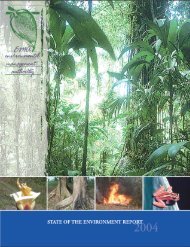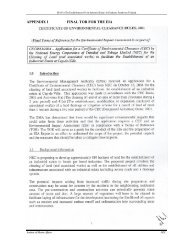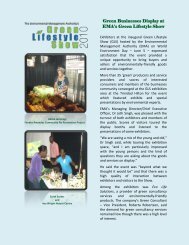Aripo Savannas Strict Nature Reserve - Environmental Management ...
Aripo Savannas Strict Nature Reserve - Environmental Management ...
Aripo Savannas Strict Nature Reserve - Environmental Management ...
Create successful ePaper yourself
Turn your PDF publications into a flip-book with our unique Google optimized e-Paper software.
The most common species in the Open <strong>Savannas</strong> are grasses, and sedges. Other notable plants of<br />
the open savanna include the carnivorous Sundew Plant (Drosera capillaris) and many terrestrial<br />
orchid species such as Pogonia tenuis or Epistephium parviflorum.<br />
Marsh Forest<br />
Marsh Forest is the community that covers the most of the land area of the ASSR. As the name<br />
implies this is a forest that grows on land that becomes waterlogged or marshy during the wet<br />
season. It is a relatively low forest, with a closed canopy populated by species that can tolerate a<br />
period of the year waterlogged. The hardpan layer found under the Open <strong>Savannas</strong> is also found<br />
under the Marsh Forest (although thinner and at greater depth) and is responsible for the flooding<br />
of the Marsh Forest as water cannot drain away through the impervious hardpan layer. There are<br />
a few species that are restricted to the Marsh Forest in Trinidad (for example the Lady Slipper<br />
Orchid Selenipedium palmifolium (Lindl.) Rchb.f.). However, the assemblage of the species is<br />
unique. There is not much overlap in the dominant species composition between the Open<br />
Savanna and the Marsh Forest. There are approximately 118 species of plants found in the Marsh<br />
Forest. The Marsh Forest in Trinidad has been severely depleted in recent years with large areas<br />
being cleared for quarrying and agriculture. At the moment the ASSR contains one of the largest<br />
and most secure fragments of this community left in the country although even in the ASSR there<br />
has been severe degradation of much of the Marsh Forest by fires that have encroached from<br />
outside the <strong>Reserve</strong>.<br />
Palm Marshes and Palm Islands<br />
These are the communities found on the fringes of the Open <strong>Savannas</strong> and in isolated clumps or<br />
islands in the middle of the savanna. They are dominated by the picturesque Moriche Palm<br />
(Mauritia flexuosa L.) that form evenly spaced stands with a thick understory of shrubs (e.g.<br />
Clidemia neglecta D.Don or Miconia ciliata (Rich.) DC.) or tall sedges and grasses (Seleria<br />
bracteata Cav. or Panicum parvifolium Lam). Because of their visibility across the savanna, these<br />
communities are also well known by visitors to the savannas.<br />
Intermittent Open Water and Trackside<br />
These are two habitats that are common in the ASSR but due to their non-natural origins or<br />
ephemeral nature are often neglected. The result of human activities, which have disturbed the<br />
area and resulted in these modified habitats, they each have a distinct suite of species adapted to<br />
their peculiar environmental conditions.<br />
4.4 Endemic, Threatened and Rare Species, and native species found only in the <strong>Aripo</strong><br />
<strong>Savannas</strong><br />
Endemic Species<br />
As mentioned earlier, the ASSR is thought to be home to two, but maybe as many as 15 species<br />
endemic 32 to Trinidad 33 . In other word these species are found nowhere else, except in Trinidad.<br />
However, there is the need for further research to confirm the status of any of the species thought<br />
to be endemic to Trinidad & Tobago. The two tentatively confirmed endemic species are both<br />
restricted to the Open <strong>Savannas</strong>. The endemics are:<br />
32 List of Plants Exclusive to the <strong>Aripo</strong> Savanna Baksh–Comeau, Y. & Quesnel, V.<br />
33 Beard, J.S. 1942. The Natural Vegetation of Trinidad. Oxford.<br />
EMA: The Administrative Record for the Designation of <strong>Aripo</strong> <strong>Savannas</strong> as an <strong>Environmental</strong>ly Sensitive Area



